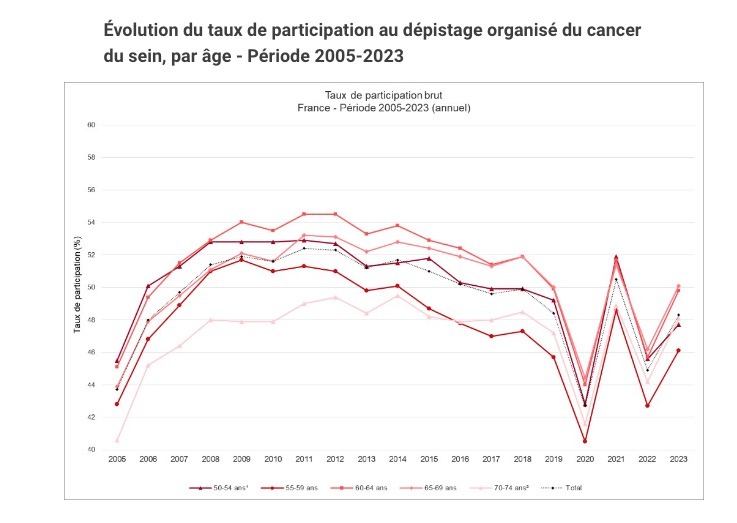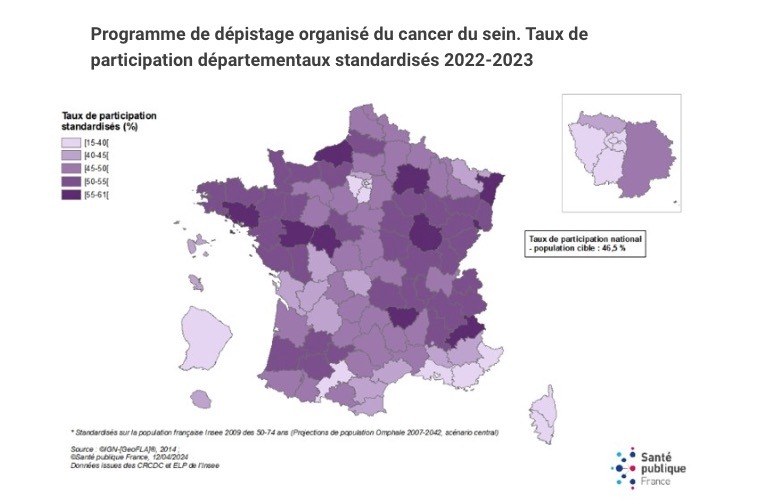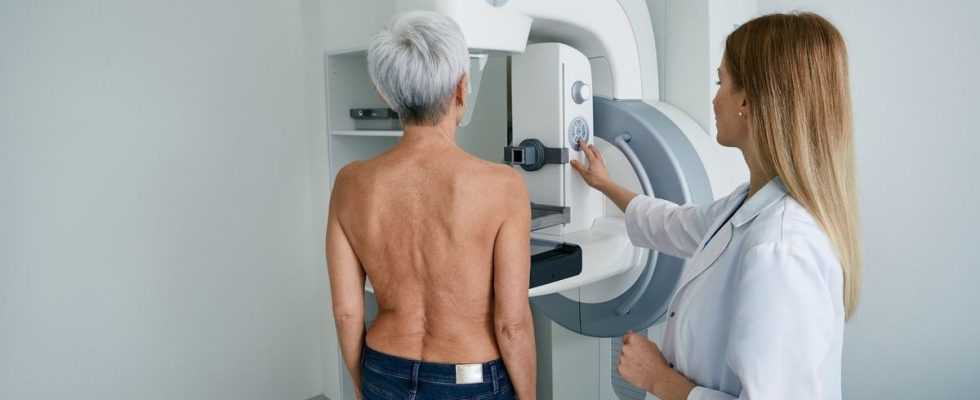Published on
Updated
Reading 4 min.
The participation rate in the national organized breast cancer screening program, intended for women aged 50 to 74, remains low in France, of around 46.5% over the period 2022-2023, according to data published by Public Health France. The rate is down compared to the previous period, i.e. 47.7% in 2021-2022, and places France at the bottom of the European ranking, far behind Denmark or Finland.
Awareness and prevention campaigns seem to do nothing to change the low participation rate in the organized breast cancer screening program in France. While nearly 10 million women aged 50 to 74 receive an invitation every two years to have a mammogram, accompanied by a clinical breast exam, just over 2.6 million of them have done so. screening in 2023, i.e. a national participation rate of 48.2%, up slightly compared to 2022 (44.8%). But if we look at participation over the two rolling years, namely 2022-2023, the participation rate is decreasing, namely 46.5% compared to 47.7% in 2021-2022, according to data presented by the national public health agency.

“The cancer detection rate is steadily increasing, consistent with the observed increase in the incidence of breast cancer in the general population. Public Health France recalls the importance of being screened as part of the organized screening program in order to detect a possible anomaly or cancer at an early stage and thus increase the chances of remission“, underlines the public health agency, specifying nevertheless that 6 out of 10 breast cancers are diagnosed at an early stage.
At the regional level, Burgundy-Franche-Comté, Normandy, and Brittany are good performers over the 2022-2023 period with the highest participation rates, while Guyana, Corsica, and Provence-Alpes -Côte d’Azur has the lowest participation rates. Note also that Hauts-de-France is the only region in which the participation rate increased in 2022-2023 – it remained stable or fell in all the others.

Obstacles to take into account
In June 2023, Public health France was already sounding the alarm about the low participation rate in the national organized screening program for the most common cancer in women. Three months later, a survey conducted by OpinionWay for the League Against Cancer told us more about the various obstacles to organized breast cancer screening. The absence of symptoms (34%), the fear of having pain (20%), or even the fear of being diagnosed with breast cancer (16%) appeared to be the main reasons why women concerned by organized screening gave it up. For more than one in ten women aged 50 to 74 (11%), this screening “is of no use”, while 8% said they did not feel concerned.
“80% of breast cancers occur after the age of 50, so this is the period when the greatest number of breast cancers can be detected. This is also the period when menopause occurs which makes the breasts less dense, and therefore where the doses of rays will be the most effective and in the least quantity. For this to be effective, mammograms must be repeated every two years because the cancer can take years to reveal itself. Screening must be seen as monitoring and not as a single and definitive result. Mammography can detect tumors that are much smaller than what can be detected by palpation. It is therefore a more effective examination than breast palpation, and complementary to it.“, explained Emmanuel Ricard, spokesperson for the League Against Cancer, in an interview with ETX Studio.
France lagging behind in Europe
Note also that France is at the bottom of the European rankings in terms of organized breast cancer screening, although the age of the women covered by such a program differs from one country to another. According to data made public by Eurostat, in 2017, the proportion of women aged 50 to 69 having undergone such screening in the previous two years amounted to 82.1% in Denmark, 81.9% in Finland, 78.2% in the Netherlands. Low, and 75.1% in the UK. The Directorate General of the European Commission responsible for statistical information specified that eight Member States had breast cancer screening rates below 50%, including France (49.7%), Lithuania (48.3%). ), and Latvia (44%).
While cancers are increasing worldwide among people under 50, some are questioning the need to increase the age at which women could be screened. For the second year in a row, the US Preventive Services Task Force, an independent public health organization, recommends mammograms from the age of 40 in the United States. A recommendation which comes precisely because of the increase in cases of cancer among younger women.
“Screening is an action that must be effective and low risk. Repeated exposure to radiation will paradoxically increase the risk of cancer. We must therefore carry out radiological examinations in order to achieve the best detection but without increasing this risk, hence the choice of the population over 50 years old. Starting earlier multiplies the doses of irradiation, and doing it in younger women with denser breasts reinforces the doses needed. It should therefore only be done in women with an increased risk, and not on a single age criterion for the entire population.“, Emmanuel Ricard explained to ETX Studio in September 2023.
The most common cancer among women in France, breast cancer is responsible for 12,000 deaths per year.
